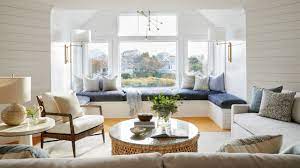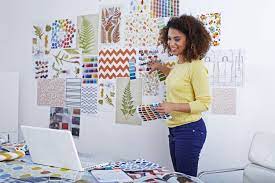The Art of Interior Design: Creating Spaces That Inspire
Interior design is more than just arranging furniture and selecting color schemes; it is an art form that transforms empty spaces into vibrant, functional environments. Whether it’s a cozy living room, a sleek office space, or a luxurious hotel lobby, interior design plays a crucial role in shaping our everyday experiences.
At the heart of interior design is the concept of creating spaces that not only look visually appealing but also serve a practical purpose. A skilled interior designer understands how to balance aesthetics with functionality, ensuring that every element in a room serves a specific need while contributing to the overall harmony of the space.
One of the key principles of interior design is the use of color and light to create atmosphere and evoke emotions. Warm tones like reds and yellows can make a room feel cozy and inviting, while cool blues and greens can create a sense of calm and tranquility. Lighting plays an equally important role, as it can highlight architectural features, create focal points, and set the mood for different activities.
Texture is another essential element in interior design, adding depth and visual interest to a space. From plush carpets to sleek marble countertops, the use of varied textures can create contrast and dimension, making a room feel more dynamic and engaging.
Furniture selection is also crucial in interior design, as it determines how people interact with their surroundings. The placement of furniture pieces can define traffic flow, create conversation areas, or establish focal points within a room. By carefully choosing furniture that complements the overall style and scale of a space, an interior designer can enhance both its functionality and aesthetic appeal.
Ultimately, interior design is about creating environments that reflect our personalities, lifestyles, and aspirations. Whether it’s through bold colors, eclectic decor elements, or minimalist furnishings, each design choice tells a story about who we are and how we want to live.
So next time you step into a beautifully designed space, take a moment to appreciate the artistry behind it. From the choice of colors to the arrangement of furniture, every detail has been carefully considered to create an environment that inspires creativity, relaxation, or productivity.
Top 7 FAQs About Interior Design: From Color Schemes to Budget Decorating
- What is interior design?
- How do I choose the right color scheme for my space?
- What are some popular interior design styles?
- How can I make a small room look bigger?
- What are the latest trends in interior design?
- How much does it cost to hire an interior designer?
- What are some tips for decorating on a budget?
What is interior design?
Interior design is the art and science of enhancing interior spaces to achieve a more aesthetically pleasing and functional environment. It involves the thoughtful arrangement of furniture, color schemes, lighting, textures, and decor elements to create spaces that not only look visually appealing but also serve a specific purpose. Interior design is about transforming empty rooms into cohesive and harmonious settings that reflect the personality and lifestyle of the inhabitants while optimizing the use of space. It is a creative process that combines artistic vision with practical considerations to improve the quality of life within a built environment.
How do I choose the right color scheme for my space?
Choosing the right color scheme for your space is a crucial decision that can significantly impact the overall look and feel of the room. Start by considering the mood you want to create – whether you prefer a cozy, intimate atmosphere or a bright, energetic vibe. Take into account the natural light in the room and how different colors will be affected by it. Understanding color theory can also be helpful; for example, warm tones like reds and yellows can make a space feel more inviting, while cool blues and greens can create a sense of calm. Experiment with swatches and samples to see how different colors interact with each other and with the existing elements in your space. Remember, there are no strict rules when it comes to choosing colors – trust your instincts and go with hues that resonate with you personally.
What are some popular interior design styles?
There are several popular interior design styles that cater to a wide range of tastes and preferences. From the timeless elegance of traditional design to the sleek minimalism of modern interiors, there is a style to suit every aesthetic. Some popular interior design styles include the cozy and inviting farmhouse style, characterized by rustic elements and vintage accents. The industrial style embraces raw materials like exposed brick and metal fixtures for a rugged, urban look. For those who prefer a more luxurious feel, the classic glamour of Art Deco design with its bold colors and geometric patterns may be appealing. Whether you gravitate towards the simplicity of Scandinavian design or the eclectic mix of bohemian decor, exploring different interior styles can help you find inspiration for creating a space that truly reflects your personality and lifestyle.
How can I make a small room look bigger?
When it comes to making a small room look bigger, there are several design tricks that can help create the illusion of more space. One effective strategy is to use light colors on the walls and ceilings, as they reflect natural light and make the room feel more open and airy. Mirrors can also be strategically placed to bounce light around the room and give the impression of depth. Choosing furniture with legs that are raised off the floor can create a sense of visual space by allowing light to pass underneath. Additionally, keeping clutter to a minimum and opting for multi-functional furniture pieces can help maximize space and prevent the room from feeling cramped. By incorporating these design techniques, even the smallest of rooms can appear larger and more inviting.
What are the latest trends in interior design?
The latest trends in interior design showcase a fusion of modern innovation and timeless elegance. From the rise of sustainable and eco-friendly materials to the resurgence of bold, statement-making colors, there is a strong emphasis on creating spaces that are both visually stunning and environmentally conscious. Minimalist designs with clean lines and clutter-free spaces continue to be popular, while incorporating natural elements like wood, stone, and plants adds warmth and texture to interiors. Mixing vintage pieces with contemporary furniture pieces is also a trend that adds character and charm to any space. Overall, the current trends in interior design emphasize personalization, sustainability, and a harmonious balance between functionality and aesthetics.
How much does it cost to hire an interior designer?
The cost of hiring an interior designer can vary widely depending on several factors, such as the designer’s experience, location, scope of the project, and the level of customization required. Generally, interior designers may charge an hourly rate, a flat fee for the entire project, or a percentage of the total project cost. On average, hiring an interior designer can range from a few hundred dollars for a consultation to several thousand dollars for a full-service design package. It’s important to discuss your budget and expectations with potential designers to find a pricing structure that works best for your needs and ensures that you receive quality design services within your financial means.
What are some tips for decorating on a budget?
When it comes to decorating on a budget, there are several tips that can help you achieve a stylish and inviting space without breaking the bank. One key strategy is to prioritize your spending by focusing on essential pieces that will have the most impact, such as a statement furniture item or a bold accent wall. Additionally, consider shopping at thrift stores, flea markets, or online marketplaces for unique and affordable decor pieces. DIY projects can also be a cost-effective way to personalize your space, whether it’s repurposing old furniture or creating your own artwork. Finally, don’t underestimate the power of decluttering and reorganizing your existing belongings to give your space a fresh new look without spending a dime. By getting creative and thinking outside the box, you can transform your home into a stylish sanctuary without breaking your budget.



